US IT Leaders Plan To Spend Big On Security, Salaries In 2024
Most midmarket CIOs have bigger budgets this year, according to a recent MES Computing survey.
Recent events, including the pandemic, have demonstrated the central importance of IT. If that were ever in doubt, it’s certainly not now.

IT spend has largely held firm, despite turbulent times. But as technology finds itself embedded in more and more areas of the business, IT leaders have a lengthening shopping list to prioritize. They need to balance defensive measures and regular upgrades with extras like supporting remote working, as well as ensuring there's enough in the pot for creative innovation.
In uncertain times, businesses turn to technology to see them through. IT budgets, while not immune to spending restrictions, are at least more resilient than some.
Of 130 senior U.S. IT leaders polled by MES Computing in December 2023, most said that real-term IT budgets had increased in the last 12 months compared with the period prior. Forty-eight percent said they had risen in real terms, versus 22 percent who reported a drop, leaving 30 percent with no change.
Those reporting an increase said the extra money would be mostly used to bolster security, refresh hardware or ERP systems or simply keep up with rising costs.
"Almost every vendor increased costs to us 5 percent to 10 percent from the previous year," said a CIO in the media sector.
Several respondents were increasing headcount as their businesses grow, while many others mentioned ongoing digital transformation, cloud and automation—all seen as essential to organizational success in the longer term.
The 22 percent who reported a decrease were disproportionately in the health and technology sectors.
"Losses due to poor reimbursement from insurance and carriers such as [Veterans Affairs], Medicare and Medicaid," reported a CIO in health care. "[My] hospital is not being reimbursed for care and services being provided. Staggering losses over the past two years are taking [a] serious toll on the hospital's finances."
Others mentioned the lasting impact of the Covid pandemic and inflationary pressures.
Indeed, several respondents, not only in health care, mentioned negative pressures, including the aftermath of the pandemic. Having expanded to meet the immediate need, budgets were now being clawed back.
Meanwhile, some in the software and technology sector pointed to the market's volatile state, while one had made efficiencies by migrating operations to the cloud.
Most of our respondents felt their major projects were achieving the expected return on investment (ROI). Given the unpredictability of supply and that, in the best of times, IT projects are notorious for cost and time overruns, this seems like a good result.
Among the 10 percent who said ROI wasn't being achieved, there was mention of over-optimism and overselling during the procurement process; benefits depending on factors outside of the control of the IT department; and unexpected problems with the new products.
"[We] spent money on projects before vetting the right solution. Funding was available from government Covid relief that included time restrictions. And, due to supply chain issues, we were rushed into decisions to procure products to meet the timelines " (Education)
"Buying more than we need. Some have the mentality of ‘have to have the latest new thing,' but then they never end up using it." (Media / Marketing / PR / Advertising)
"In many cases systems promise to provide more streamlined processes and less user involvement, but we generally find that user interaction is still critical to the integrity of the data." (Media / Marketing / PR / Advertising)
Where Is The Money Going?
IT makes up 6 percent to 10 percent of total organizational spend on average, according to our respondents. So, what are IT leaders spending it on?
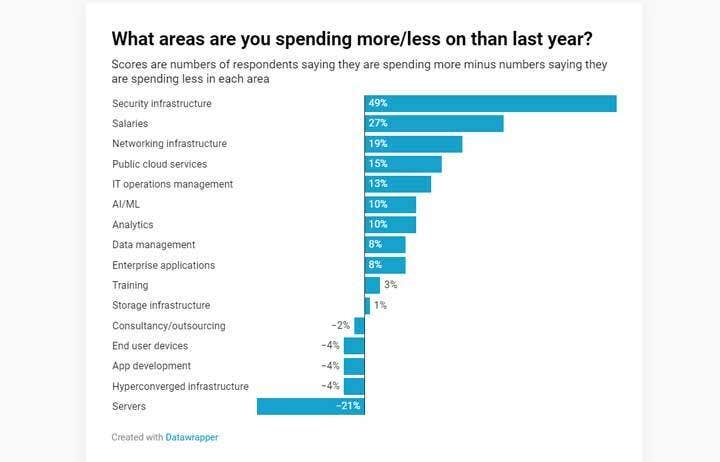
The top item will come as no surprise: cybersecurity.
Fifty-one percent said they were spending more on security infrastructure, versus 2 percent who said they were spending less, giving a net figure of +49 percent, as seen in the chart above.
Sadly, this picture is unlikely to change any time soon. The ransomware business is just too lucrative, state-sponsored actors find it too easy to break and enter, and they seem increasingly willing to do so; and with supply chain attacks, everyone is a target, if only as a steppingstone to larger prey. It sometimes feels like a losing game.
"Cybersecurity is one of the things that keeps my team up at night. Anything we can do—within reason—to help secure our data is continually being reviewed." (Banking / Finance / Insurance)
Some mentioned the sorry state of the world.
"The conflict in the Middle East has seen increased phishing and security-related activity targeted as fund-raising, as well as attempts to social engineer responses from staff." (Non-profit)
Others discussed the fact that regulations and safeguards meant more boxes to tick, as well as rising insurance premiums.
"The continued push for more regulations and compliance standards around cybersecurity have changed how we have to report and implement solutions. The impact has created additional areas of concern to report on and build programs around." (Agriculture)
Salaries
Second on the list of places money is being spent was salaries. The IT skills gap is still very much impacting midmarket CIOs, and workers with a talent for security, AI/ML, data science and DevOps can command hefty compensation packages and pick and choose from what's on offer.
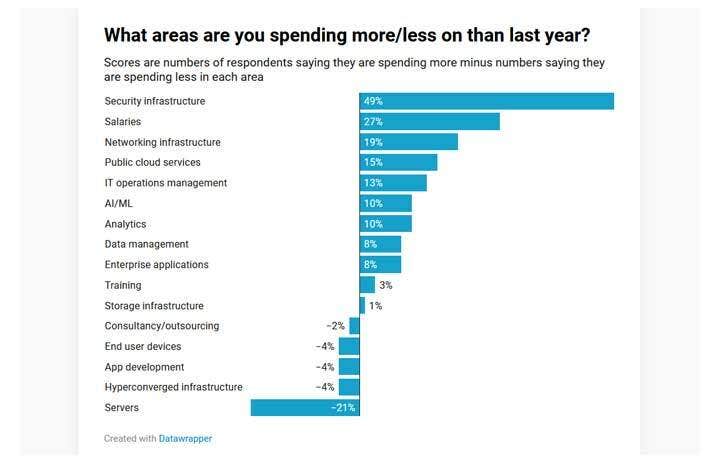
And it does seem businesses are finding it particularly tough to attract the right IT talent. Forty percent said it's harder to recruit this year than last year, versus just 14 percent who said it was easier.
Forty-eight percent of respondents felt their location was unlikely to attract these highfliers, while 52 percent—more than half—felt the same about their sector, which may just be a reflection of the fact that recruitment is difficult for almost everyone right now.
Everyone Needs A Network
Next up were network services.
The Covid pandemic has significantly increased network infrastructure investments as organizations adapted to remote work and digital operations. It also highlighted the patchy broadband coverage in many more remote areas, adding weight to demands for better infrastructure.
"We were due for a system refresh before Covid hit, and now we have many systems incapable of being updated and must be replaced." (Food services)
Broadband infrastructure is also a strategic priority for government investment, and the market for network infrastructure in the country is projected to grow further and faster as a result.
Better security is another driver for network upgrades.
Cloud: Still On The Rise
Fourth on the list of higher spend was public cloud.
Public cloud services are encroaching on more and more business activities, both as a platform for third-party services and as a way to connect various applications, locations and data sources together in a hybrid setup.
We do hear the occasional tale of "declouding," but the trend is still very much in the other direction, which is why, year-on-year, revenues at the big cloud companies continue to rise in double-digit percentages.
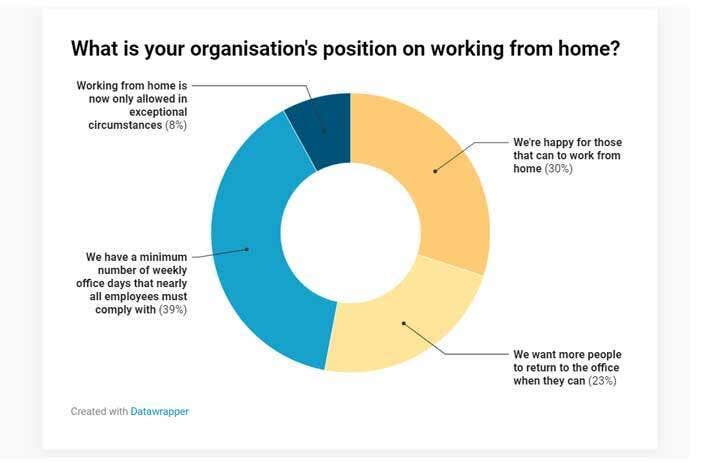
Of course, the cloud companies had a very good pandemic as many more people were forced to work remotely. Despite a significant push in some quarters to roll back to Normality 1.0, more than half of our respondents demonstrated a relaxed attitude to working from home (WFH). Thirty percent said, "We're happy for those that can to work from home", while 23 percent favored the carrot over the stick, coaxing people back to the office rather than laying down the law.
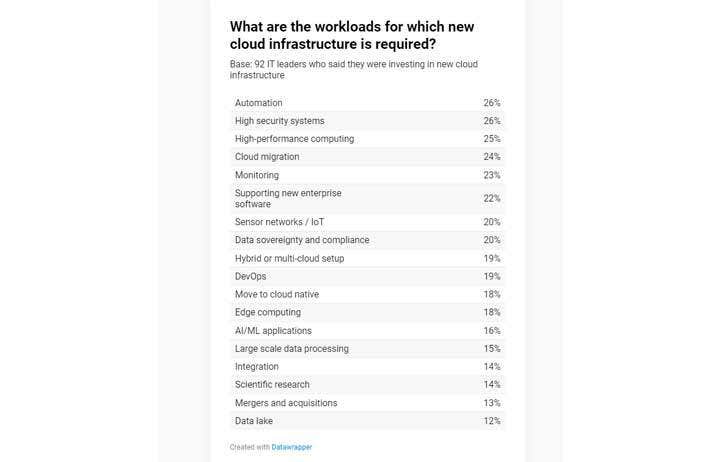
Cloud is also seen as a crucible for innovation. As well supporting WFH, storage, backup & recovery and office use cases, respondents investing in new cloud infrastructure were pursuing automation (26 percent), high-security systems (26 percent), high-performance computing (23 percent), cloud migration (24 percent) and monitoring (23 percent) programs.
However, cloud prices have been rising, often at above-inflationary rates. Organizations continue to take measures to optimize costs, including eliminating over-specified or underused cloud infrastructure and modernizing cloud infrastructure.
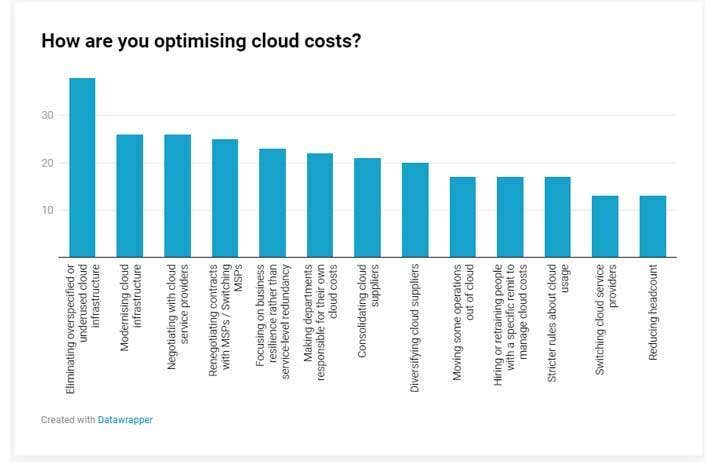
Doing More With Data
Below cloud services on the spending graph (at the top of this article) comes IT operations, then a clump of three related topics: data management, AI/ML and analytics.
The capacity to use data to support decision-making and automation—and to provide the basis for innovation—is one reason that IT budgets have remained reasonably intact. It's something that most businesses just can't do without. Nevertheless, it's AI that's grabbing much of the attention at the moment.
This is much broader than AI. Sixteen percent of the respondents were actively adopting more AI/ML. Another 30 percent said they're consuming more passively, as AI appears in products and services they use.
A few of the many AI-enhanced use cases respondents had been pursuing over the past year are listed below.
- Using in place of search when information gathering
- Automating legal processes
- Predictive maintenance
- Onboarding and offboarding staff
- Supply chain optimization
- Assisting with coding
For some, ChatGPT has taken the place of search engine. A risky strategy perhaps, given LLMs' acknowledged propensity for hallucinating, but so long as users are aware of that and check sources carefully, AI chatbots are undoubtedly useful for gathering and summarizing information.
Then there was automating customer services, onboarding and offboarding employees, predictive maintenance, cyber security and assistance with coding.
"Just starting to look at ChatGPT and evaluating Copilot." (Science)
"Through analyzing data and logs we're using AI to bring the important data to the forefront. This allows us to address the priorities first." (Real estate)
"Software dev assistance, marketing content creation, and IT support" (Banking & finance)
"Writing SOPs and procedures" (Energy and water)
As well as using off-the-shelf chat bots, several organizations are actively experimenting with their own AI/ML models, using AI on their internal data to drive automation and insight.
The majority of respondents said they expect AI to have a significant impact on their businesses in the next two or three years. Forty percent predicted that AI would bring gains in productivity. The possibilities here are almost endless, from automating routine communications to assisting decision-making, to streamlining supply chains, and all the cases mentioned above. A slightly higher proportion (42 percent) said AI will improve customer service.
Thirty-six percent said AI will perform many marketing tasks, and 35 percent that it will write code with little human intervention. Security (30 percent) was the other big topic.
Spending Slowed On Servers
Companies are spending more on end user devices. The pandemic saw major supply-side issues with laptops, and prices increased with the supply shortages.
Meanwhile, spend on servers seems to be falling, likely displaced by cloud.
On average, respondents were spending less on training outsourcing and consultancy too. Some of these support services may be seen as a nice-to-have when resources are squeezed.
Open To Open Source?
Almost all software contains open-source code, but actively choosing to use open-source software as a policy and/or contribute to open-source code over proprietary alternatives remains a minority play.
Twenty-four percent of respondents said their organization has a policy to use or contribute to open-source software, versus 73 percent who said they do not.
Using open-source software can be a valid way to save money on expensive licensing, but at the business level the most common driver for its use is obtaining functionality unavailable in proprietary offerings, which may mean contributing to the code base.
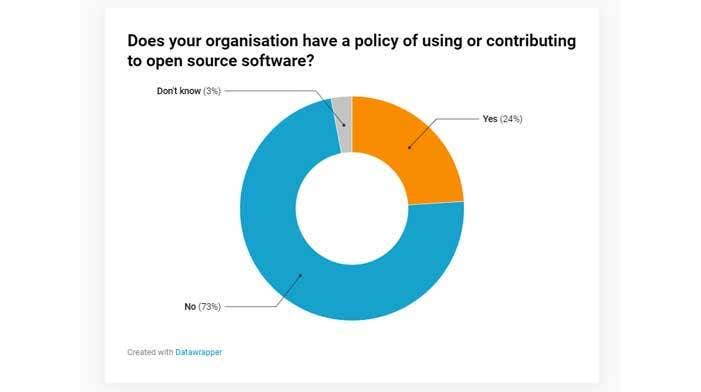
Contributors to open source were disproportionately in the banking & finance and (unsurprisingly) software sectors, both heavily reliant on cutting edge innovation. A small majority of those using and/or contributing to open-source software said they would continue to do more of both in the future, although a number said they would turn to proprietary solutions when they can deliver the required functionality.
"Use of open-source software has proven risky, and we will limit the number of tools being used, both open source and proprietary," said a senior technology manager in the energy and water sector.
An IT leader in the technology sector indicated that open source is now widely accepted: "Policy and team members are more focused on open source, including team members whose sole task is open-source licensing compliance."
Currently the jury seems to be out on open source, with organizations weighing the possibilities of bespoke innovation against the complexity of managing and securing it.
Inflation, Interest Rates And Instability
The conflicts in Ukraine and the Middle East cast a worrying pall over several businesses.
"We have an office in Ukraine. We have had to build out more local infrastructure." (Manufacturing and Engineering)
"UAE office rent severely affected and so [are] our contract rates." (Architecture)
High inflation and elevated interest rates had caused plans to be delayed 14 percent.
"Software in particular has increased dramatically year over year." (Education)
"We've seen significant increases in Opex and Capex spending. Additionally, customers have been very resistant to our attempts at pricing increases." (Business & Professional Services)
"The price of services being passed down the supply chain is starting to show up in my invoices from my partners." (Manufacturing and Engineering)
"The issues with the supply chain ... as well as rising interest rates and an uncertain geopolitical environment make investing in companies like ours not as lucrative or attractive." (Media / Marketing / PR / Advertising)
Optimistic Outlook
As with budgets, more respondents were optimistic about the coming months (37 percent) than the other way around (13 percent). They felt that the dark days of the pandemic are now behind us, inflation seems to have peaked, order books are filling up and new work arrangements have stabilized.
Why do you feel more optimistic about your business in the coming year?
"Infrastructure and operations have been finely tuned this year. This should pave the way for a more optimized year." (Real estate)
"We have come through rough times before and have a roadmap of success that is shared throughout the leadership of the company." (Manufacturing and Engineering)
"Economy is clearing up, supply chain is better and overall customer price increases are stabilizing" (Hospitality)
"Competitors leaving the market. Good positioning." (Media / Marketing / PR / Advertising)
"We have a lot of additional revenue due to state and federal grants, which has allowed us to push forward with some big projects that have been needed for a long time." (Distribution and Transport)
"Pulling out of the Covid years, we have concrete goals to achieve and the support to do them." (Education)
However, this feeling was not universal. Respondents from public sector, health, media and business & professional services were the least optimistic about the future, citing challenging economic conditions, cutbacks and the difficulty in raising fees to counter inflation.
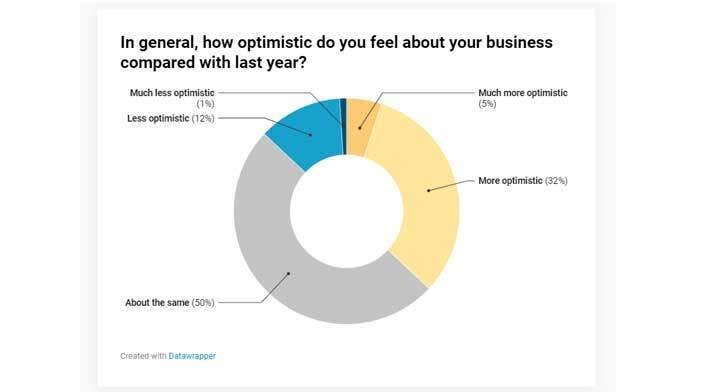
Why do you feel less optimistic about your business in the coming year?
"Major financial losses are beginning to have serious impacts on services. We are cutting many non-essential services in hopes of keeping the most important things running." (Health)
"Major organizational changes are driving major cultural changes." (Media / Marketing / PR / Advertising)
"We are in a very tough and struggling industry. Publishing/media is dying everywhere." (Media / Marketing / PR / Advertising)
"The global landscape has changed dramatically in the past 12 months, and that has had negative impact on our business and key ex-U.S. partners." (Health)
"Management has chosen to not pursue newer enterprise applications nor improve existing ones, and this stagnation causes me to lack optimism." (Business & Professional Services)
Summing Up
Despite continued uncertainty on many fronts, U.S. IT budgets have shown remarkable resilience over the past year. While some organizations have had to trim expenditures, most IT leaders report stable or growing spend.
Funds are being invested in cloud migrations, cybersecurity, automation and AI/ML—technologies viewed as essential in an increasingly uncertain world—and the salaries of those tasked with implementing them.
IT departments know their role is more crucial than ever to drive efficiency, enable remote work and support data-driven innovation. Although skills shortages, inflation and supply chain woes continue to cause headaches, with some sectors seeing real-term cuts, most IT leaders remain cautiously optimistic about the coming year. Their skills only grow more vital as businesses push through the turbulence. For U.S. organizations hoping to stay competitive and effective, keeping IT priorities funded is imperative.